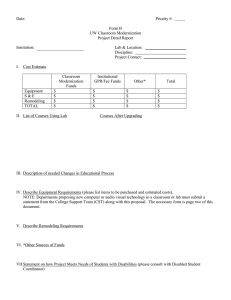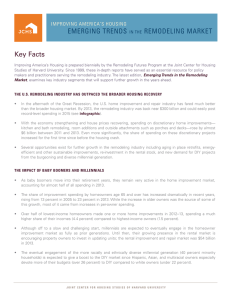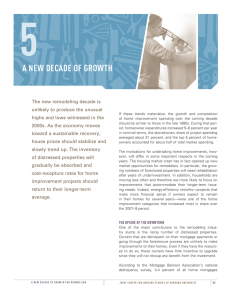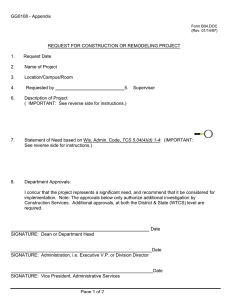Introduction and Summary Like the overall housing market, the US home improvement
advertisement
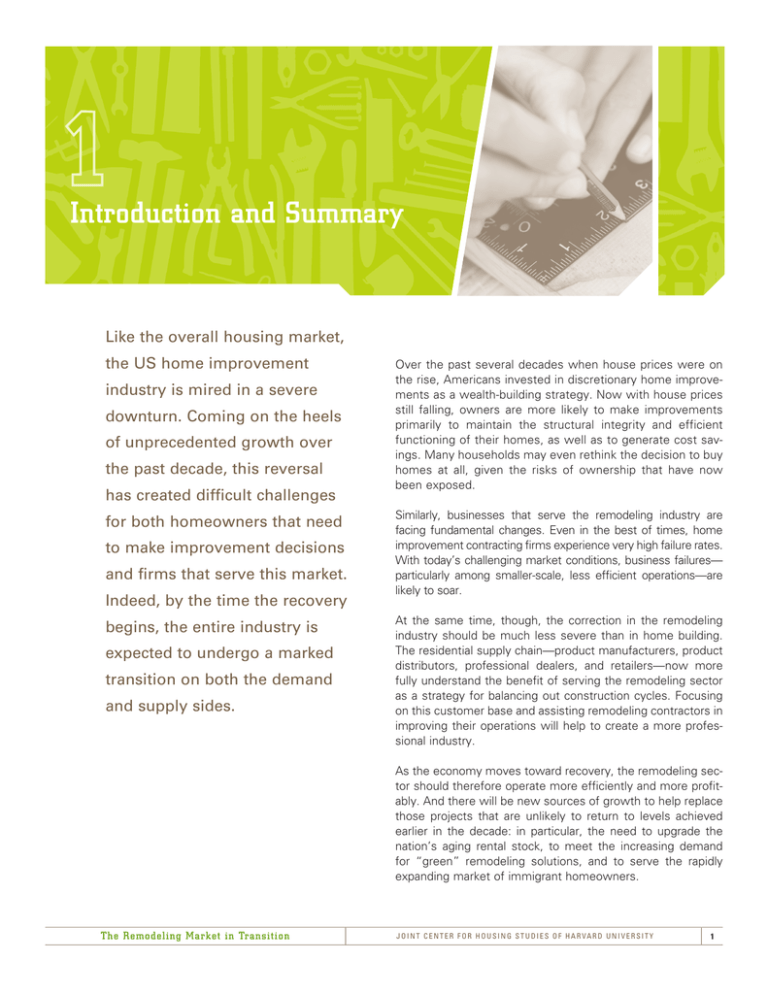
Introduction and Summary Like the overall housing market, the US home improvement industry is mired in a severe downturn. Coming on the heels of unprecedented growth over the past decade, this reversal has created difficult challenges for both homeowners that need to make improvement decisions and firms that serve this market. Indeed, by the time the recovery begins, the entire industry is expected to undergo a marked transition on both the demand and supply sides. Over the past several decades when house prices were on the rise, Americans invested in discretionary home improvements as a wealth-building strategy. Now with house prices still falling, owners are more likely to make improvements primarily to maintain the structural integrity and efficient functioning of their homes, as well as to generate cost savings. Many households may even rethink the decision to buy homes at all, given the risks of ownership that have now been exposed. Similarly, businesses that serve the remodeling industry are facing fundamental changes. Even in the best of times, home improvement contracting firms experience very high failure rates. With today’s challenging market conditions, business failures— particularly among smaller-scale, less efficient operations—are likely to soar. At the same time, though, the correction in the remodeling industry should be much less severe than in home building. The residential supply chain—product manufacturers, product distributors, professional dealers, and retailers—now more fully understand the benefit of serving the remodeling sector as a strategy for balancing out construction cycles. Focusing on this customer base and assisting remodeling contractors in improving their operations will help to create a more professional industry. As the economy moves toward recovery, the remodeling sector should therefore operate more efficiently and more profitably. And there will be new sources of growth to help replace those projects that are unlikely to return to levels achieved earlier in the decade: in particular, the need to upgrade the nation’s aging rental stock, to meet the increasing demand for “green” remodeling solutions, and to serve the rapidly expanding market of immigrant homeowners. The Remodeling Market in Transition J o i n t C e n t e r F o r H o u s i n g S t u d i e s o f H a r va r d U n i v e r s i t y 1 Following the Construction Market Down Even though remodeling activity held on until the end of 2007, the retreat was sharp. Now about a year into the downturn, homeowner spending on improvements has already dropped almost 16 percent and all of the major indicators suggest that the bottom of the cycle is some time away (Figure 1). Existing home sales are a primary driver of home improvement spending because buyers typically want to make changes to their new homes upon purchase. According to Joint Center for Housing Studies (JCHS) research, households that relocate spend an average of 20–25 percent more on improvements than otherwise similar households that do not move. But with existing home sales off nearly 30 percent in the third quarter of 2008 from their recent peak, the number of new owners who might undertake improvements has also fallen sharply. At the same time, depressed home prices provide owners less equity to finance projects, and today’s credit market restrictions make it increasingly difficult to borrow whatever equity remains. During the spectacular run-up in house prices earlier this decade, owners extracted so much equity from their homes that mortgage debt accounted for an increasing share of the aggregate value of the owner-occupied housing stock. Federal Reserve Board estimates show that home equity made up almost 65 percent of the stock’s value in the late 1980s; by 2007, however, it accounted for less than half. Since the beginning of 2007, homeowner equity has not only declined relative to mortgage debt, but it has also dropped in absolute terms because of the plunge in home prices. Falling home prices have also reduced the incentive to make home improvements. Owners who might otherwise undertake remodeling projects with an eye toward increasing the value of their homes often wait until house prices stabilize to decide which improvements make the most financial sense. Another reason to wait out price cycles is that the share of cost recovered from home improvement projects typically increases when house values are rising and decreases when values are falling. In their most recent annual survey, Remodeling magazine and the National Association of Realtors® (NAR) found that cost recovery declined steadily from an average of 87 percent in 2005 to just over 67 percent in 2008. Also undermining the growth in remodeling expenditures is the recent surge in mortgage delinquencies and foreclosures. Owners of homes at risk of or in foreclosure generally have little to spend on improving or even maintaining their properties. In addition, many of the owners displaced by the foreclosure process either become renters or move in with other households, thereby reducing the national homeownership rate. Since homeowners contribute a much larger share of overall improvement Figure 1 Major Indicators Point to Further Remodeling Declines Change from recent peak Remodeling Indicators Recent Peak Date of Peak 2008:3 Levels Change 6.3 2005:3 4.4 -29.4% Median Existing Single-Family Home Sales Price (Thousands of $, seasonally adjusted) 226.4 2005:4 195.9 -13.5% Owner Equity in Household Real Estate (Billions of $, non-seasonally adjusted) 12,496 2005:4 8,530 -31.7% Share of Cost Recovered from Remodeling Projects (%) 86.7 2005 67.2 -19.5pp Homes in Foreclosure (Thousands, non-seasonally adjusted) 395 2005:3 1,351 242.0% National Homeownership Rate (%, non-seasonally adjusted) 69.2 2004:2 67.9 -1.3pp Existing Single-Family Home Sales (Millions, seasonally adjusted annual rate) Notes: The number of homes in foreclosure is measured from its recent trough in 2005:3. The share of cost recovered from remodeling projects is compared with the annual 2008 number. pp=percentage point. Sources: National Association of Realtors®® (NAR), Existing-Home Sales Series; US Census Bureau, Current Population Survey and Housing Vacancy Survey; Federal Reserve Board, Federal Flow of Funds; Mortgage Bankers Association, National Delinquency Survey; and Remodeling magazine, Cost vs. Value Survey. The Remodeling Market in Transition J o i n t C e n t e r F o r H o u s i n g S t u d i e s o f H a r va r d U n i v e r s i t y 2 Figure 2 The Remodeling Market Continued to Expand Rapidly through 2007 Billions of dollars 350 300 250 200 $161 14 26 26 $180 18 26 31 100 $149 20 21 23 50 85 95 105 1995 1997 1999 150 $210 23 25 33 $229 25 33 $280 18 31 $326 20 32 46 43 37 228 188 129 134 2001 2003 0 � � � � 2005 2007 Rental Maintenance Rental Improvements Owner Maintenance Owner Improvements Sources: JCHS tabulations of the 1995–2007 American Housing Surveys (AHS) and the US Department of Commerce Survey of Expenditures for Residential Improvements and Repairs (C-50 reports). spending than rental property owners, declines in the homeownership rate imply reduced demand for remodeling. Shifts in Home Improvement Activity Remodeling expenditures—including maintenance, repairs, and improvements to rental and owner-occupied homes and the properties on which they are located—more than doubled to an estimated $326 billion between 1995 and 2007 (Figure 2). The current downturn is therefore all the more dramatic given the magnitude of spending growth during this period. Between 2003 and 2007 alone, overall spending increased 43 percent while homeowner spending jumped 60 percent. On average, every owner spent $1,160 more on home improvements in 2007 than in 2003. Even between 2005 and 2007 when home building was headed down, remodeling activity was still posting healthy gains. Spending by homeowners was up by an average of 9.3 percent over this two-year period, while spending by rental property owners increased just 3.5 percent. With these gains, expenditures on owner-occupied units contributed fully 84 percent of the remodeling market in 2007, with improvements (in contrast to more routine maintenance and repairs) accounting for 70 percent of the total. The healthy growth in the remodeling market in 2006 and early 2007 reflected a continuation of the forces that had The Remodeling Market in Transition helped to propel spending to its earlier record-breaking pace: solid activity at the upper end of the market; concentration on kitchen and bath projects; increased share of installations by professional contractors; and strong gains in owners living in homes that were appreciating in value. New trends, however, were also beginning to emerge during this period that point to the changing direction of the remodeling industry. In particular, the share of homeowners making improvements is back on the rise, broadening the base of households in the market. In 1995, almost 60 percent of homeowners reported having undertaken one or more projects in the previous two years. This share trended down through 2003, when fewer than 54 percent of owners reported projects over a two-year period. Improvement activity began to pick up again in 2005, with nearly 58 percent of homeowners reporting at least one project by 2007. Related to this trend is the reduced concentration of spending. In 1995, the top 1 percent of owners accounted for almost 19 percent of all homeowner remodeling expenditures. These were the owners who undertook extensive projects such as whole-house remodels, high-end kitchen and bath improvements, and home additions. Remodeling activity became even more concentrated over the ensuing decade, with the top 1 percent of owners accounting for more than a third of all expenditures in 2005. The recent surge in home improvement spending was therefore driven by a fairly thin slice of J o i n t C e n t e r F o r H o u s i n g S t u d i e s o f H a r va r d U n i v e r s i t y 3 high-end projects, apparently built on debt carried by the runup in house prices and therefore not sustainable. By 2007, however, this share dipped back under 29 percent. During the period of unprecedented growth in improvement spending, homeowners turned their attention to projects that would enhance the use of space and upgrade the products and finishes within the home. Kitchen and bath remodels, as well as other room additions and alterations accounted for 37 percent of homeowner spending in 2007, up from 33 percent in 1995. Similarly, other interior additions and replacements (flooring, wall, and ceiling finishes) made up another 12 percent of spending—almost double the 1995 share of 7 percent. With this strong focus on interior projects, spending on exterior replacements and system upgrades lost share. Looking ahead, though, the shares of spending across these broad project categories is likely to return to longer-term averages. In fact, these shifts have already begun to occur, with expenditures on electrical, plumbing, and HVAC systems and on major equipment on the rise between 2005 and 2007. Adjustments in the overall housing market are also driving changes in the composition of spending. Earlier in this decade, household mobility increased significantly as owners attempted to take advantage of rapidly rising house prices. In a typical year, 6.5–7.0 percent of owners relocate. From 2003 to 2006, however, owner mobility averaged 9 percent and peaked at almost 10 percent in 2005. With the current housing downturn, mobility is likely to return to its longer-term trend. Lower mobility rates imply not only lower levels of improvement spending, but also changes in spending priorities. Recent buyers devote a larger share of their home improvement dollars to interior projects such as kitchen and bath remodels, other room additions and alterations, and interior replacements (Figure 3). Undertaking these discretionary projects soon after purchase allows buyers to avoid disruptions once they move in and to enjoy the improvements for the entire time they occupy the homes. Longer-term owners, in contrast, devote a larger share of their budgets to system and equipment upgrades and to exterior replacements. These owners typically made discretionary improvements soon after they purchased their homes, so their current spending often focuses on replacing essential elements and maintaining their homes in good repair. Geographical Differences in Spending Nationwide, homeowner spending on improvements averaged just over $2,300 per year between 2000 and 2007. But spending levels varied widely across metropolitan areas. Markets where house price appreciation was unusually strong earlier in the decade, such as the California coast and the Eastern seaboard, also posted unusually high levels of homeowner improvement spending (Figure 4). At the other extreme, areas where the local economy was weak (such as Cleveland and Detroit) or where the pace of home building kept price appreciation in check (such as Houston, Dallas, and Denver) saw much lower spending levels. Figure 3 New and Long-Term Owners Have Different Spending Priorities Average share of spending, 2005–2007 Recent Buyers Long-Term Owners 4% 7% 21% 19% 17% 15% 12% 12% � � � � � � Kitchens and Baths � Disaster Repairs 19% 13% Other Room Additions Systems and Equipment Exterior Replacements Interior Replacements 14% 11% Property Improvements & Outside Attachments 23% 13% Notes: Recent buyers have owned their homes for less than 2 years, while long-term owners have been in their homes for more than 20 years. See Table A-1 for project category definitions. Source: JCHS tabulations of the 2005 and 2007 AHS. The Remodeling Market in Transition J o i n t C e n t e r F o r H o u s i n g S t u d i e s o f H a r va r d U n i v e r s i t y 4 Figure 4 Most High-Spending Home Improvement Markets Experienced Rapid House Price Appreciation Earlier in the Decade Average annual improvement spending per homeowner, 2000–2007 � Seattle $3,200 � Boston $4,100 Minneapolis $4,000 � Chicago $3,000 � � Detroit $2,300 � Cleveland $2,000 San Francisco $4,300 � � Denver $2,200 � New York $3,400 � Philadelphia $2,800 � Washington $3,500 Los Angeles $4,200 � San Diego $4,400 � � Phoenix $2,300 � Dallas $2,200 Houston $2,000 � Notes: Sample includes metro areas with an average age of $1 billion per year in homeowner improvement spending in 2000–2007. 07. Estimates are in 2007 dollars. Source: JCHS tabulations of the 2001–2007 AHS. In the current housing market environment, price appreciation will be much less of a factor in remodeling spending. Indeed, many of the markets that had the largest increases in house prices earlier in the decade now have the largest declines in improvement expenditures. This could reverse the geographical patterns of spending over the next few years. In addition, the collapse of house prices in some areas has left many owners with virtually no equity. The economic forecasting firm Moody’s Economy.com estimates that as of late 2008 more than 15 percent of US homeowners were living in units that had less value than their outstanding mortgages. Given the continued drop in house prices, Moody’s Economy.com expects this share to peak at about 20 percent by the end of 2009. Owners with little or no equity in their homes are unlikely to make significant improvements until house prices stabilize. Even those with substantial equity may be unable to make improvements because they cannot meet today’s stringent credit standards. The wave of foreclosures will, however, provide future opportunities. As noted previously, owners at risk of default are unlikely to make improvements to their homes, and foreclosed homes are often vandalized. As housing markets recover, though, many of these homes will be rehabilitated either by banks to make them more attractive for sale or by The Remodeling Market in Transition � Miami $2,300 their new owners. Areas where foreclosure rates are high may therefore see a resumption of home improvement spending as markets begin to recover. To assist in this process, the Housing and Economic Recovery Act of 2008 allocated $4 billion to state and local governments for the redevelopment of abandoned and foreclosed properties. Sources of Industry Growth As the remodeling industry emerges from the downturn, the sources of growth will be much different than those in the past decade. Three market segments should help to offset the drag from the weak housing market: continued growth in the number of immigrant homeowners, the need to upgrade the aging rental stock, and increasing consumer interest in green remodeling activities. First, foreign-born homeowners currently account for more than 10 percent of home improvement spending. Not only do immigrants represent a growing share of new household formations, but they are also very active in the improvement market. Immigrants are younger households, heavily concentrated in their 30s and 40s—the ages when families are growing and changing the uses of their homes, and therefore the ages when homeowners begin to spend more on remodeling. J o i n t C e n t e r F o r H o u s i n g S t u d i e s o f H a r va r d U n i v e r s i t y 5 In addition, the rental housing stock is in dire need of improvements after years of underinvestment. During the homeownership boom, weak demand for rentals discouraged owners from upgrading their units. Indeed, spending on rental units increased less than 30 percent between 1995 and 2007, compared with more than 150 percent for owner-occupied units. Because of the near-term slack in the housing market, some of the excess supply of owner-occupied units will be temporarily converted to rentals, thus reducing the need for new rental units. In the longer term, however, growth in the renter population will increase the demand for rental housing. With low levels of construction activity over the past decade, the median age of the rental stock has risen to 36 years (4 years older than the owner-occupied stock), leaving many units in need of upgrading. Finally, the public’s growing interest in sustainable housing is expected to provide a boost to the remodeling industry in the years ahead. While initially focused on energy efficiency, consumers have recently shown increasing interest in quality and durability issues, environmental performance, and safety and disaster mitigation products. Energy efficiency is one area where the economic benefits of green remodeling are readily apparent. Given that existing homes consume 22 percent of the nation’s energy, the introduction of green systems could have a tremendous impact on national consumption (Figure 5). With homes built before 1970 (before the first OPEC oil embargo when energy was relatively inexpensive) responsible for about 40 percent of residential energy use, the stock of older homes provides a prime market for energy-efficient upgrades. Moreover, the foundation of the remodeling industry is solid. The US housing stock consists of nearly 130 million homes in ongoing need of maintenance, component replacement, and adjustments to meet changing preferences and lifestyles. With one to two million homes added to the housing inventory each year, future growth in home improvement activity is assured. Figure 5 Older Housing Contributes Substantially to National Energy Consumption Energy consumption by sector Transportation 28% Industrial 32% Built before 1950 4% Built 1950–1969 5% Built 1970–1989 7% Commercial 18% Residential 22% Built 1990–2005 6% Source: US Department D t t off Energy, E Energy E Information I f ti Administration, Annual Energy Review and Residential Energy Consumption Survey, 2005. The Remodeling Market in Transition J o i n t C e n t e r F o r H o u s i n g S t u d i e s o f H a r va r d U n i v e r s i t y 6
